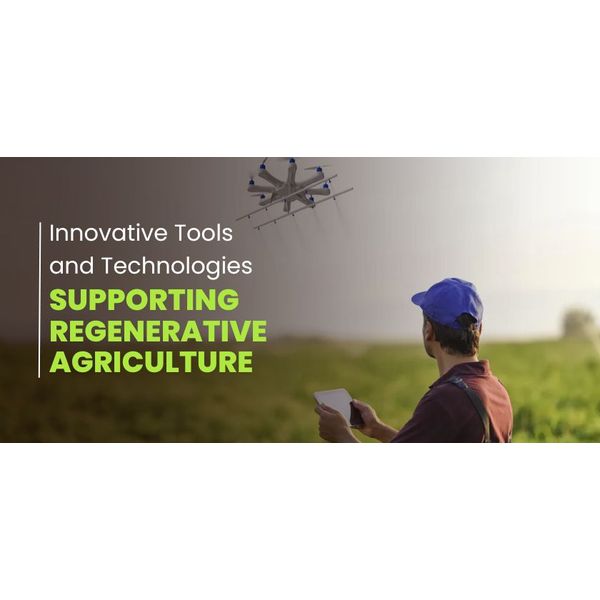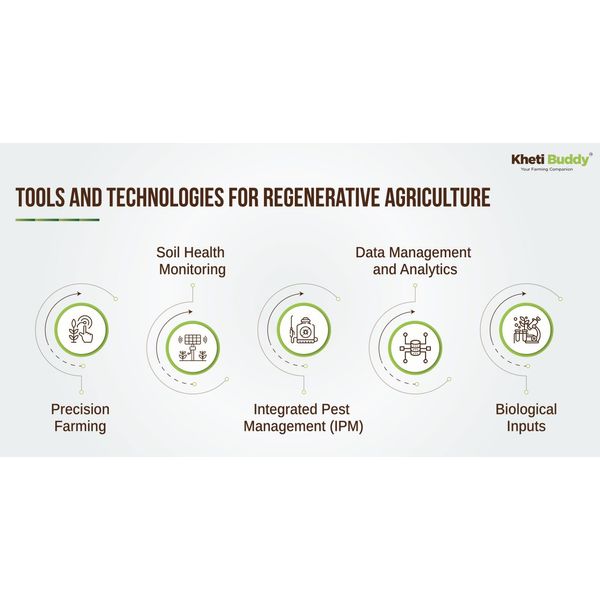

- Home
- Companies
- Kheti Buddy
- Articles
- Innovative Tools and Technologies ...
Innovative Tools and Technologies Supporting Regenerative Agriculture
As global agricultural practices address environmental and economic challenges, regenerative agriculture has stood out as a promising approach to creating more sustainable and robust farming systems. This farming method focuses on restoring soil health, enhancing biodiversity, and improving water cycles, ultimately leading to more sustainable food production. Innovative tools and technologies are playing a critical role in supporting regenerative agriculture practices, making them more efficient and scalable.

Regenerative agriculture is a holistic farming approach that aims to restore and boost natural ecosystems. Unlike traditional farming methods that often consume resources, regenerative practices improve soil health, increase biodiversity, and promote long-term environmental sustainability. Key principles of regenerative agriculture include:
- Soil Health Improvement: Practices such as cover cropping, reduced tillage, and organic amendments improve soil structure, fertility, and microbial activity.
- Biodiversity Enhancement: Integrating diverse crop species and promoting natural habitats for beneficial organisms support ecosystem resilience.
- Water Management: Techniques such as contour farming, rainwater harvesting, and efficient irrigation systems help conserve water and improve water quality.
- Carbon Sequestration: By increasing organic matter in the soil, regenerative agriculture helps capture and store atmospheric carbon, mitigating climate change.
While regenerative agriculture practices offer numerous benefits, they also present several challenges, such as:
- Initial Transition Costs: Shifting from conventional to regenerative practices often requires significant upfront investments in new equipment, seeds, and soil amendments.
- Knowledge and Training: Workers need to acquire new skills and knowledge to understand regenerative practices effectively, which can be a barrier for those accustomed to conventional methods.
- Economic Viability: Ensuring that regenerative practices are economically attainable and can compete with conventional farming in terms of yield and profitability is crucial for widespread adoption.
- Monitoring and Verification: Measuring the impact of regenerative practices on soil health, carbon sequestration, and biodiversity can be difficult and resource-intensive.
- Market Access: Farms may need to find new markets for regenerative products, which can be challenging without established supply chains and consumer demand.

Innovative tools and technologies are essential in overcoming the challenges of regenerative farming practices and enhancing their effectiveness. Here are some of the key tools and technologies driving this agricultural revolution:
Precision Agriculture
- GPS-Guided Equipment: GPS technology facilitates precise planting, fertilization, and irrigation, reducing waste and optimizing resource use.
- Drones: Equipped with multispectral cameras, drones can monitor crop health, assess soil conditions, and identify pest and disease outbreaks, allowing for targeted interventions.
- Variable Rate Technology (VRT): VRT systems adjust the application rates of inputs such as seeds, fertilizers, and pesticides based on real-time field data, improving efficiency and reducing environmental impact.
Soil Health Monitoring
- Soil Sensors: These devices measure soil moisture, temperature, pH, and nutrient levels, providing real-time data to refine irrigation and fertilization practices.
- Lab Testing: Extensive soil testing services analyze soil samples for nutrient content, organic matter, and microbial activity, which help in making informed decisions about soil amendments.
Data Management and Analytics:
- Farm Management Software: Platforms having a unified agtech platform integrate data from various sources, offering insights into crop performance, soil health, and resource use. These systems support data-driven decision-making and long-term planning.
- Remote Sensing: Satellite imagery and remote sensing technologies provide large-scale monitoring of agricultural lands, helping identify trends and measure the impact of regenerative practices.
Biological Inputs
- Biofertilizers and Biopesticides: These products use beneficial microbes and natural compounds to improve soil fertility and control pests, reducing reliance on synthetic chemicals.
- Compost and Organic Amendments: Adding organic matter to the soil improves structure, fertility, and water-holding capacity, promoting healthy plant growth and carbon sequestration.
Integrated Pest Management (IPM)
- Natural Predators: Encouraging the presence of beneficial insects and other natural predators helps control pest populations without harmful chemicals.
- Pheromone Traps: These traps attract and capture pests using species-specific pheromones, reducing pest pressure in crops.
The future looks promising, with ongoing advancements in technology and increasing recognition of the benefits of regenerative agriculture for food security and environmental sustainability. Here are some trends and developments to watch out for:
- Increased Adoption of Technology: As tools and technologies become more accessible and affordable, more agribusinesses are likely to adopt regenerative practices, leading to wider implementation and greater impact.
- Market Demand for Regenerative Products: Consumer awareness and demand for sustainably produced food are growing, creating new market opportunities and encouraging transition to these practices.
- Collaborative Research and Innovation: Continued research and collaboration between agronomists, scientists, and technology providers will drive innovation and the development of new tools and techniques to boost regenerative agriculture.
- Climate Change Mitigation: Regenerative agriculture’s potential to sequester carbon and improve ecosystem resilience makes it a crucial component of global climate change mitigation strategies.
Regenerative agriculture offers a sustainable and resilient approach to farming that can address many of the challenges facing modern agriculture. By using innovative tools and technologies, agribusinesses can increase the effectiveness of regenerative practices, improve productivity, and contribute to environmental sustainability. As the agricultural industry continues to develop, the adoption of regenerative agriculture will play a crucial role in ensuring a sustainable future for food production.
By using KhetiBuddy’s Unified Agtech Platform, you can take your agriculture practices to the next level! Our advanced crop management solutions provide you with the tools and insights you need to perform regenerative practices effectively while ensuring sustainability.
